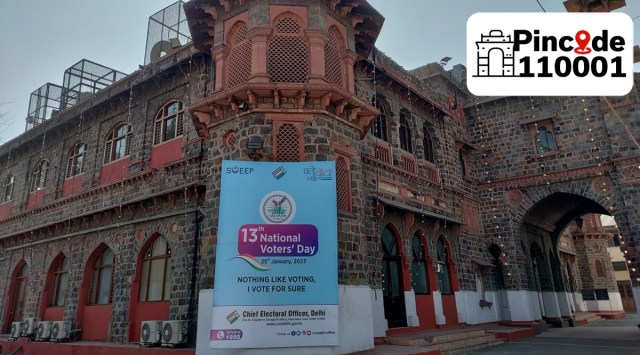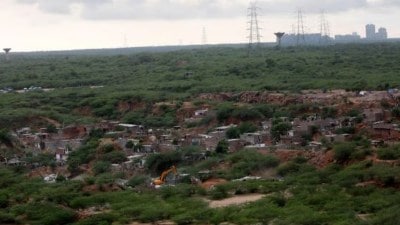Decked up for the 13th National Voters’ Day, the structure that once housed St Stephen’s College, from 1891 to 1941, today provides an ample hearth and home to the Delhi State Election Commission office. Although wires, an array of lights, a large balloon bearing the office name try to take away the building’s character, the majestic porch, a large lamp, and its foundation stone allude to an era predating modern-day Constitutional offices.
In the 1870s, Bishop Douglas of Bombay advised that ‘men of high scholarship who would live in a religious community and work amongst educated classes of India’ be sent, which later formed the Cambridge Mission. The Mission started from Westcott House, Cambridge, and carried forward the motto, “For My Sake and the Gospel’s”.

On February 1, 1881, to assist the mission’s founder principal Rev Samuel Scott Allnutt in teaching five young men, the first students, a college was set up with three teachers in the centre of Chandni Chowk at a rented building known as Shish Mahal. As students poured in, even the additional adjacent house was incapable of lodging growing numbers. At the 100th meeting of the Mission Council, Allnutt proposed two sites for a college building at Kashmere Gate and Lahori Gate; fortune favoured the former.
On April 9, 1890, Sir Charles Elliott, head of the Public Works Department, laid the foundation stone of the building, designs for which were furnished by Colonel Sir Samuel Swinton Jacob, then Chief Engineer of Jaipur State. Later, on December 8, 1891, Delhi L-G Sir James Lyall inaugurated the Kashmere Gate structure.
Sohail Hashmi, writer and director, said the college’s journey from a rented room to its sprawling campus came out of a dire necessity: “When the college sought affiliation with the University of Punjab, the varsity demanded they shift to a permanent residence from their rented, humble abode at Chandni Chowk. Following this, the college, with government aid, bought land and shifted to the Kashmere Gate campus.”
An exquisite building, standing tall with red sandstone and iron grey granite semi-octagonal turrets, arched colonnades, white domes, and green lawns, added up to Rs 92,702. It had Indo-Saracenic style architecture, foregoing the favoured Gothic style, and the building flaunted a secular character.
Historian Swapna Liddle said the task cut out for Swinton was to Indianise buildings: “Swinton Jacob was originally associated with the New Delhi project, to assist Edwin Lutyens and Herbert Baker in the design of New Delhi. Although ailing health forced him to pull out of the assignment and leave India, his contribution to the style of architecture with chhatris, jaalis and jharokhas made him a pioneer of the Indo-Saracenic style of architecture. These characteristics are visible in the Kashmere Gate structure.”
Story continues below this ad
Above the front porch of the building, the college’s motto in Latin reigned supreme, ‘Ad Dei Gloriam (To the glory of God)’. In the hall, it said, “Jesus said, I am the Light of the World. He that followeth Me shall not walk in Darkness but shall have the Light of Life”, and on the wall behind were the words ‘Satyameva Jayate Namratam’ from the Mundaka Upanishad.
Though several historians, including David Baker, have claimed St Stephen’s College aimed to convert students to Christianity, this is debunked by Ashok Jaitly, an alumnus and former Chief Secretary, J&K, in his work, St Stephen’s: A History. He writes that though there were attempts to give an overall religious orientation to teaching, “over time, even whilst continually reaffirming the Christian spirit that inspired and drove successive administrations, it was the bedrock of powerful secular and pluralist values upon which the college evolved”.
Following the shifting of capital from Calcutta to Delhi in 1911, the college building nestled close to the seat of governance, thus making it favourable for students to engage in politics. The college was next to St James cathedral, the principal church in the early 1900s, bestowing the college with even more distinction.
Dr Mahesh Gopalan, professor at the department of history, St Stephen’s college, said, “When the nationalist movement was raging, the students faced a dilemma. Even then, Principal SK Rudra was torn between the British government and the nationalists. The Kashmere Gate building was at the heart and witnessed the struggle, and its closeness to Old Delhi catalysed the student involvement in the movement. The campus had the Mori Gate ground on one side, hostels, and the college on the other. These buildings were spread over that part of the city and became synonymous with the movement in Old Delhi.”
Story continues below this ad
This was quite contrary to the life students lived after the campus was shifted. “By then, the independence movement had plateaued, and later, the matters Independent India encountered did not invite participation from students. Their lives changed, and even the new building, confined to a single plot, restricted the students’ lives and views,” he added.
In 1913, Mir Chand, a Stephanian allegedly involved in a bomb attack against Viceroy Lord Hardinge, was defended by Allnutt during his trial. Chand and Avadh Behari, another student, were sentenced to death in the Delhi conspiracy case.
On October 4, 1914, Rabindranath Tagore visited the college, exhorting students by issuing the clarion call for ‘Indian unity’, to defy the diversities tearing them apart. So goes another parable that Tagore completed his English translation of ‘Gitanjali’ while on campus.
The following year, after Mahatma Gandhi’s stint in South Africa, he visited the college and stayed on campus with Principal Rudra. History has it that it was on the campus, in the principal’s house, where Gandhi enunciated his doctrine of non-violence, non-cooperation movement. Moreover, it was here the pact between the Congress and Khilafat Movement was sealed.
Story continues below this ad
St. Stephen’s brags of many firsts, most notably, the first to replace sectarian messes with inter-dining halls, and many of these exploits originated from the Kashmere Gate campus. Jaitly in his book substantiates how common college dinner was practised to encourage integration and to nip the communal barriers at a time when “religious separatism” was cropping up in every sphere of life.
In 1922, when the University of Delhi was created through an act of the Indian legislature, St Stephen’s was one of the three constituent colleges, apart from Hindu and Ramjas colleges.
Even today, Stephanians treasure memories of their former hub of education. The Dhaba, a famous eatery on the current campus till two years ago, was more a remnant of its ancestor pan shop at Kashmere Gate. “Run by Sukh Ram, popularly called Sukhia, it sold pans, later pedas and barfis. When the campus shifted, Sukhiya also shifted base. The shop was run by Sukhiya’s son Rhotas. Once, when Muhammad Zia-ul-Haq, former President of Pakistan, visited his alma mater, Rhotas reminded him of the debt Zia owed his father,” laughs Dr Gopalan.
Today, the building that accommodates the DEC office and carries all the legacy blends into the background. Hashmi said, “Even the Allnutt Hall at Kashmere Gate, which was the first hostel on the campus, was demolished around 15 years ago… As the election commission office takes up the whole building, the offices and inventory have made it impossible to preserve the college as it was.” Pointing at a room with a nameplate that read ‘accountant’, a DEC official said the room was occupied by Gandhi during his visit. “It has nothing except government files now, and the room is used by the officer,” he said.









